
 |
|
|||||||
| Forum Rules | Firearms Safety | Firearms Photos | Links | Library | Lost Password | Email Changes |
| Register | FAQ | Calendar | Today's Posts | Search |
 |
|
|
Thread Tools | Search this Thread |
|
|
#1 |
|
Junior Member
Join Date: June 19, 2007
Posts: 3
|
DPMS LR308T odd brass dynamic going on
First post here… and I'm already looking for advice
 . I’m rapidly learning about internal ballistics and chamber design and have found the study fascinating. I haven’t learned enough yet though to know what I’m looking at on this though... I have a new DPMS, LR308T (.308 semi-auto AR) that’s chamber appears to be stretching the case head excessively (lengthwise, as if it was excessively headspaced) but it’s only on about 20-40% of the case head circumference (only on one side, if you will). Many cases are to the point that I wouldn’t dare to reuse the once fired brass out of fear of it separating. . I’m rapidly learning about internal ballistics and chamber design and have found the study fascinating. I haven’t learned enough yet though to know what I’m looking at on this though... I have a new DPMS, LR308T (.308 semi-auto AR) that’s chamber appears to be stretching the case head excessively (lengthwise, as if it was excessively headspaced) but it’s only on about 20-40% of the case head circumference (only on one side, if you will). Many cases are to the point that I wouldn’t dare to reuse the once fired brass out of fear of it separating. The chamber checked out fine with a .308 NO-GO gauge, even though the barrel is stamped 7.62x51. I called DPMS and they said that it is chambered in .308. The fella I talked to there didn’t have a real good answer to my question why they stamped them 7.62x51 then, but anyway… Another odd thing is that it doesn’t do it on every case (using the same ammo) and some brands of brass seem to do it more frequently. Winchester seems to be the worst, Remington second, and Federal the least (roughly 70%, 50%, and 30% respectively show the flow issue). It is also beginning to look like it does it in the same spot in the chamber (the stretched side seems to be in the same relative circumferential position in respect to the extractor mark on the case) but I’m not 100% sure on that yet though. I need to look at some more cases to confirm that. I’m wondering if the chamber isn’t square to the bore, or the if chamber isn’t square to the bolt (i.e. the barrel extension is out of square to the bore??). Does that make any sense? Would an overly rough or overly smooth, or variably rough and smooth, chamber do that? When I look into the chamber, the walls look “normal” but it does appear to be a little rough in the shoulder/wall junction area (can see one distinct tool-mark ridge at the wall/shoulder junction on one side – it is enough to leave an impression of it on each case, maybe .002” deep). Is it just a peculiarity with these rifles? Is it a consequence of the variable cartridge headspace and/or brass hardness in different brands of ammo/brass? It is worth noting that the rifle shoots ½ MOA and better when fed good ammo and loaded single load by hand. It has also grouped well with 150gr, 175gr and 180gr fodder so far. The rifle was also exhibiting signs of being overgassed when I first got it – failure to extract and locking back on an empty mag, ripping the rim hard via the extractor, ejecting at 1 o’clock, etc. The cases didn’t exhibit any signs of high pressure (measured or visually) and didn't fit hard into the chamber. An adjustable gas block took care of all of those symptoms though. Anyone have any thoughts on what’s causing the odd case head stretch? |
|
|
|
|
#2 |
|
Senior Member
Join Date: December 5, 2004
Location: In the Vincent, Ohio general area.
Posts: 1,804
|
cases
Sir:
First, welcome to the Forum! Can you send us a picture of your cases? That would be a dead-nuts way to tell what's wrong. You say the cases are stretching lengthwise - have you measured that? Did the locking, lock on the no-gop guage. What happens with so many rifles, new and old, is that even though the headspace is within tolerance, if it's loose (.006 is the tolerance an rimless) when fired, the primer will look like there is excess headspace - flattened! The case grips the side-walls of the chamber and the primer backs out slightly and is flattened in its recess. If you can, send us pictures and I'm sure we can figure it out. Does this rifle have a fluted chamber? Are you shooting factory? Don't pay any attention to the argument of 308 versus 7.62X51 - they're identical except for a slight pressure spec difference and slight difference in guages. Give us some pictures and more info. Harry B. |
|
|
|
|
#3 |
|
Senior Member
Join Date: August 24, 2001
Location: LC, Ca
Posts: 1,917
|
Are you shooting reloads? If so, is your sizing die moving the shoulder back and creating a case stretch issue?
|
|
|
|
|
#4 |
|
Junior member
Join Date: November 25, 2002
Location: In my own little weird world in Anchorage, Alaska
Posts: 14,172
|
First thing to do is send it back to DPMS with some fired cases.
WildeasyfixAlaska |
|
|
|
|
#5 | |||||||
|
Junior Member
Join Date: June 19, 2007
Posts: 3
|
Wow, that was quick!
Hey fellas, thanks for getting on it! I think I'll like it here!
It's late so I'll be brief for now and get back with more tomorrow night... quote: HarryB Quote:
Quote:
Quote:
Quote:
Quote:
Quote:
Quote:
 (so much for the "brief" part) (so much for the "brief" part) I'll get back to this tomorrow night. Oh, "wildalaska"... good advice, I just want to know what I'm looking at so I can present the issue to DPMS lucidly, or even determine if there is an issue I guess. If folks can help me confirm an issue, I have no interest in buggering anything up and voiding the warranty, or worse, gettin' myself kilt I'll get back to this tomorrow night. Oh, "wildalaska"... good advice, I just want to know what I'm looking at so I can present the issue to DPMS lucidly, or even determine if there is an issue I guess. If folks can help me confirm an issue, I have no interest in buggering anything up and voiding the warranty, or worse, gettin' myself kilt  Thanks fellas Bedtime.............. Last edited by morrison; June 20, 2007 at 12:28 AM. Reason: clarifying for a tired typist |
|||||||
|
|
|
|
#6 |
|
Junior Member
Join Date: June 19, 2007
Posts: 3
|
Picture is worth a thousand words
It is to my disappointment I won't be able to post much more this evening other than a few pics. The tabulating of data will not occur this evening and I may actually be MIA for a day or two here - my clock really needs to be a 34 hour one. Buuut... the pics have something to say. Both photos are the same exact photo. The first shows the area of contention, the second has a visual reference (straight line) added to highlight the degree of geometry change at the case head. This is a case from a factory Federal Power-Shok 180gr (P/N 308B) fired in my rifle with a very clean chamber. The case head has this geometry for about 30% of the circumference, the opposite side ("down" in photo) is as straight as can be from the shoulder all the way to the extractor goove. This is an excellent example of all the cases that have this artifact. Hope this is illustrative and gets the wheels turning until I can tabulate some more data and post it.
|
|
|
|
|
#7 |
|
Senior Member
Join Date: May 30, 2005
Location: Holland
Posts: 199
|
Judging from the pics. and no more than judging:
It looks like a too (?) large unsupported case length. Chamber tight, but öpen space, but not neccessarily headspace, too long. Given the fact You talk about a semi auto, the Feeding chamfering (Funnel on the back of barrel) for lack of a better description might be a tad too deep. Best advice, send it back including a notice that tou put your(their?) problem on the forum. That might entice them to demonstrate their aftersales quality. Good luck |
|
|
|
|
#8 |
|
Member
Join Date: February 15, 2007
Posts: 75
|
Details
What it looks to be is a case of minor case expansion, and that would be more visible when on one side of the case. This does not look to be unsupported case, just the normal and necessary clearance to let ammo fit into a chamber. The expansion does not reach the head due to the case wall being thin only to that point of the expansion showing.
(Normal design of these guns is to have a portion of the rear of the case fit into the recess of the bolt head. That's how they make something without an extractor groove cut at the rear of the barrel. There is normally very little clearance between the front of the bolt and the back of the barrel.) The case head is much thicker and doesn't exhibit the same pressure signs as the thin wall area of the shell. If you had a gun that showed no such sign on any of the shells that you fired, your gun would be too sensitive to any grit or fouling accumulation, and would probably not extract the case in a semi-auto. There needs to be clearance room, and expansion-rebound of the case is a given. Take a look at other fired cases from everyone else's guns, and you will see the same effect. Some are just a little more visible than others. You will ALWAYS be able to measure a diameter change in front of the case head between fired and factory unfired cases. You have checked with a headspace gauge. You know you do not have excess headspace. You do not have cases stretching more than anyone else with the same dimensions of headspace. [email protected] |
|
|
|
|
#9 |
|
Junior member
Join Date: November 25, 2002
Location: In my own little weird world in Anchorage, Alaska
Posts: 14,172
|
Send it back
WildodidisaythatAlaska |
|
|
|
|
#10 |
|
Senior Member
Join Date: May 30, 2005
Location: Holland
Posts: 199
|
Kirby,
Took my swedish m96 out to the range today because your statement about ALLWAYS seeing these signs on spent cases, had me puzzled,. Being a very carefull reloader (only 25 years) and not remembering ever such a case, I was "apprehensive". But, again, as allways, no such increase in diameter. Cases, as all metals, do not return to previous dimensions, if they are stretched beyond elasticity. That's not how it is supposed to be. If you do, the deformation is permanent. That's why you: A. Have things called neck sizing dies (i.e. only the neck needs to be resized, so the rest fits WITHOUT resizing, B. I have been shooting my 586 for close to 25 years, homemade reloads only, granted, light loads, WITHOUT EVER RESIZING my cases (Federal) that I bought together with the gun. I repeat my first advice completely in line with wildalaska, send it back. Last edited by dutchy; June 24, 2007 at 08:56 AM. |
|
|
|
|
#11 |
|
Senior Member
Join Date: December 5, 2004
Location: In the Vincent, Ohio general area.
Posts: 1,804
|
cases
Sir:
I looked at your cases. There appears to be nothing wrong with them. I think KIRBYTHEGUNSMITH may be on the right track. Cases that have some expansion you can see (milspec rifles are somewhat lax with the standards) are common in milspec rifles. If you have ejector and extractor marks though something is amiss! If so, I'd second the "sending it back." Harry B. |
|
|
|
|
#12 |
|
Member
Join Date: February 15, 2007
Posts: 75
|
Details
Dutchy, would you please re-read my post.
I said that the comparison is between factory shells, not reloads, especially not low-pressure loads. I appreciate the fact that you can get long life from your special treatment, and have a fine Swedish made gun. Unfortunately, we are talking a modern mass-production gun copied from the AR school of design, and with many parts that need enough clearance to operate in an environment of gas fouling and more. Also, for everyone's notice, is that I am only commenting about the case expansion as my primary info.  There are 4 cases fired from the 7400 I was testing, with the most visible section shown for each. Here are 4 more of a different brand. 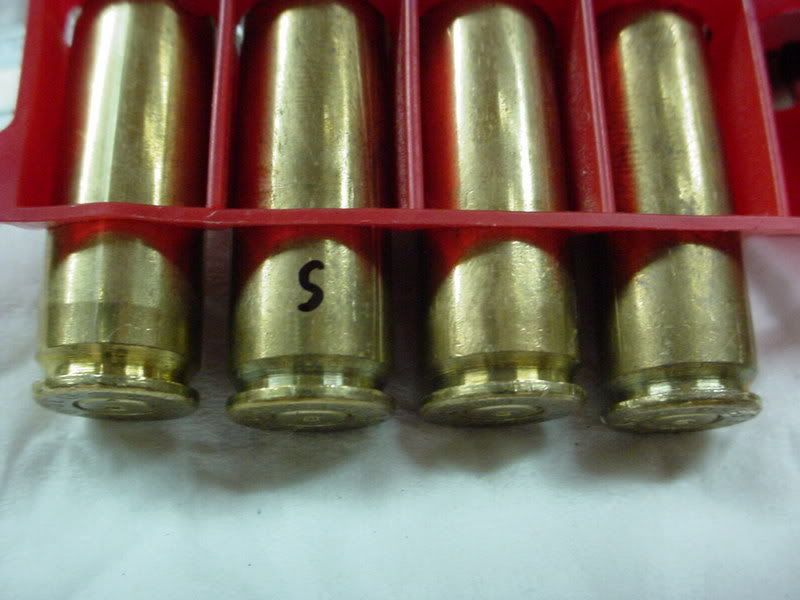 Here is a Remington shell showing the expansion does not reach the web area in front of the rim cut, same gun. 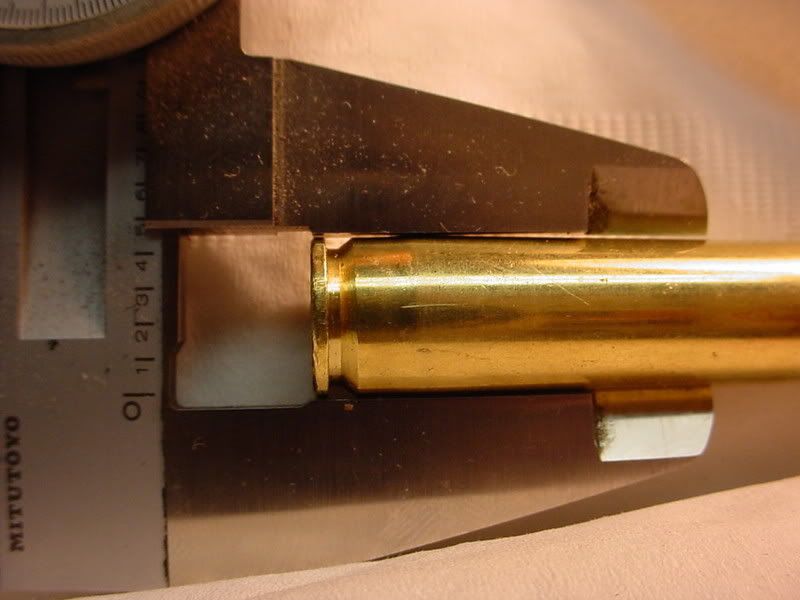 The originals unfired measured around .464, and this fired shell was .469", with the others within about .001-.002 of those dimensions. Just for your comparison, here are different factory shells from the same gun to compare primer cratering of factory loads. Expect these views to be in the normal expected range.  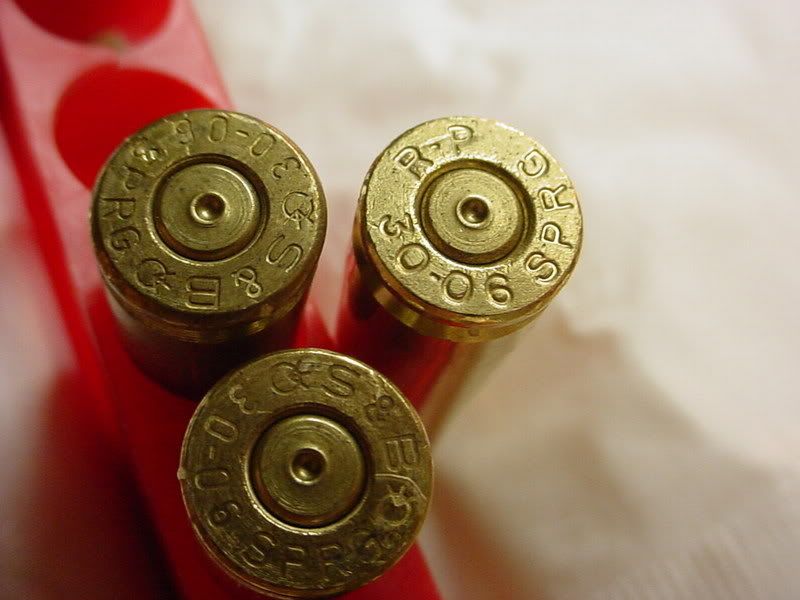  Very observant people might have noticed something unusual in one picture. What was there to see? [email protected] |
|
|
|
|
#13 | |
|
Junior member
Join Date: November 25, 2002
Location: In my own little weird world in Anchorage, Alaska
Posts: 14,172
|
Quote:
WA |
|
|
|
|
|
#14 |
|
Senior Member
Join Date: May 30, 2005
Location: Holland
Posts: 199
|
Kirby,
Sorry if I misread your post, just tryin' to give my 2 cents, free of charge. However, no need for tolerance whatsoever justifies bulging of cases in my book, especially not if my hands are holding the gun in question. Looking at your primers, I see, in my humble opinion, clear signs of high pressure (setback of striker indentations). Something else worries me. You talk about .308 / 7.62 x 51. The cases in your picture are headstamped .30-06 though. I guess a .308 no go gauge would go in a .30-06 chamber, oversized or not, excessive headspace or not. Take a close look, the ring type tool marks of the boltface are visible on the case heads. Last and final well meant advice: have it checked. Dutchy |
|
|
|
|
#15 |
|
Member
Join Date: February 15, 2007
Posts: 75
|
Details
One more time: please read the post of mine. There may have been some confusion, but since I do a lot of my posting late at night, please bear with me, and understand those conditions.
I did not mention any caliber. The original post was referring to a .308, but I never stated that I was showing the shells for that specific gun. I was showing shells from a 7400 that I was testing. "Morrison" had a DPMS .308, though. WA and Dutchy, I understand your expectations for primers not having any craters, from handload books for reading pressure signs. The loads are meant to be measured and compared to the results from firing factory loads in the gun, so you have benchmarks for the expectations of the cases you desire to use. You also benefit by benchmarking each firearm to judge the eccentricities that each may have that exhibits in each type of case component. It would be nice if we always had perfect examples to use to make comparisons and never had to worry about "adequate", but my budget is not always "adequate". (Do you realize that cratering can happen from alternate issues besides excess pressure, at least for small amounts? A little excess chamfer of the firing pin hole in the breechface and a gap in the diameter of the hole vs. the firing pin tip are both examples that may cause an apparent cratering, but that's not pressure-related.) The type of materials will have certain properties that may vary from one mfg. to another due to alloy, thickness of the case (why do you think handloaders weigh the cases) and primer cup materials and thickness, and so on. You cannot make a specific pronouncement of the firearm suitability or not from the small amount of cratering of these cases pictured. There is going to be alternate and visible pressure signs that should be present here to judge for excess pressure, but where are the excessively flattened primers? That still must be gauged against known benchmarks. How else do you judge what is too flat, or too cratered, or has tool marks from the bolt face? Remember, the 7400 gas operation makes the gun unlock and that involves rotating the bolt, all while the pressure is still elevated above atmospheric, and the case rebound has not occurred to a significant degree, so the case will probably not turn at all while the bolt face DOES turn to unlock. Pressure of the case against the boltface due to the shell grip still being against the chamber wall, rotation of the bolt prior to the withdrawal and subsequent extractor tug on the rim, and the gradual release of the case/chamber wall grip enough to allow the inertia gained by the mass of the bolt and slide assembly to maintain enough velocity to fling that puppy free- now you see why you have rub marks on the case head and primer from the bolt rotating, and the ejector plunger makes a rub or 2, especially when the rounded tip passes over a letter of the headstamp. This is a totally different cycle than any manually operated gun. Chamber grip is well known enough to explain the HK fluted chamber concept to "float" the case a little with some gas bleed along the case wall. I mention "case" expansion to mean CASE WALL, not CASE HEAD, OK? Realize that there is also ALWAYS going to be a difference in the chamber size than the case (which will always be smaller, if properly spec'd), and a subsequent expansion of the case during firing. ALWAYS. The only time a case will fail to expand, is when you run such a feeble handload or similar situation that fails to generate enough pressure to obturate the case, and you'll see a lot of blackening to prove the point. The case (metal or plastic, shotguns included) is the SEAL that prevents leakage of the hot powder gas back into the action and your face, so you do want the case to expand. You don't want an oversize chamber, but how can you judge oversize if you don't measure and compare to spec., but instead rely on the MK.IV eyeball. Once more, you can see that the case HEAD area has not expanded in the pictures, or else you wouldn't see a demarcation area in the thin wall area of the case. Have you ever seen cartridge case cut-away pictures showing the thicker brass near the rim area (except on old balloon-type cases) while they usually make only a side comment about that material, because the reloader articles tend to show a thinned area from case stretching and preach to shooters to avoid a separated case, which is always good advice. I have not gotten a response about the "special" condition present in a picture in the previous post. If you happen to spot the problem, you are astute. I didn't spot it right off, either. I'll have more to post later, including the answer to match the picture. [email protected] |
|
|
|
|
#16 | |
|
Junior member
Join Date: November 25, 2002
Location: In my own little weird world in Anchorage, Alaska
Posts: 14,172
|
Quote:
Like I said. WildnomatterwhatthecauseacrateredprimerisnotgoodAlaska PS all the internet expetise notwithstanding, gun needs to go back. |
|
|
|
|
|
#17 |
|
Senior Member
Join Date: May 30, 2005
Location: Holland
Posts: 199
|
Wildalaska,
I think we rest our case(s). For some sideways related info,: Read Frank de Haas, Bolt action rifle. There is a story about a 6,5 mm Arisaka with a 30-06 chamber (only). Bore remained 6,5. Nice story, just for the fun of it. Allways cautious, Dutchy. Last edited by dutchy; June 24, 2007 at 01:42 PM. |
|
|
|
|
#18 |
|
Senior Member
Join Date: May 30, 2005
Location: Holland
Posts: 199
|
Kirb,
My sincere apologies, I just saw I was responding to you while thinking I was responding to Morrison. That explains the .308/30-06 mix up. My opinion on your cratering however remains unchanged. If the boltface/strikeropening gap is significant, I would get it fixed if only to be able to notice overpressure if it would occur. |
|
|
|
|
#19 |
|
Member
Join Date: February 15, 2007
Posts: 75
|
Details
WA, I noticed that you never happened to make any case-expansion specific comments, but Dutchy did.
[By the way, I never remember seeing any centerfire rifle with any type of feed ramp as a part of the rear section of the barrel (like on pistols) that could leave a section of the case unsupported. There does need to be a rounding of the edge, or chamfer (like Dutchy's partial comment) at the rear edge for eliminating scraping of brass. Feed ramps for rifles tend to be a section of the frame, and wherever located, would definitely be a poor design to leave a high pressure case unsupported in any section, at least nothing larger than an extractor clearance cut.] I also never made comments about whether the DPMS in question needed to be returned. I posted the information about case expansion marks as being an insufficient reason (by itself) to generate any concern, so Morrison could then concentrate on any other conditions without worry about headspace or chamber size. WA, I was not impugning your talents when I posted about the alternate cratering conditions. Do you agree that a minor chamfer present on a bolt face firing pin hole does not necessarily require remedial action, once it's presence is verified? I do agree with you, Dutchy, on the one point about a narrow firing pin in an oversized hole needs fixing, but a chamfer that is just a bit oversize is not worth the effort to fix, and Remington would be very likely to tell you that there is no need for concern, and now you owe them for the shipping back. If I were building a custom Mauser etc. and the bolt had a chamfer, then re-machine the face prior to barrel installation. If you notice it on a gun, the cost is impractical for most people for a non-danger related condition. If you have those benchmarks archived, you have a way to compare for EXCESS cratering, flattening of the primer, and so forth. I also expect that when I post information, some of the more basic aspects must be included for the other readers that may not be up to speed of a gunsmith or knowledgeable shooter, and therefore, don't take comments about basic conditions (or whatever) as if they were an "in your face" comment about personal ability, talent, or knowledge base. If you readers have seen my posts at thehighroad.org, you will notice that I provide generous heaps of details there, also. I try to not be sensitive to comments that don't rise to the level of insults, but rather deduce that they are a plea for greater information to elevate their understanding. If someone feels that I am in error, details can always sway me to a point of correct thinking, but nay-saying can't increase my knowledge, so how can I change my mind, then? A note for any interested readers, is to look at "Hatcher's Notebook" for a plethora of details about so many interesting details that you'll have a hoot seeing everything from massive powder magazine failures and ordnance catastrophes to the infamous low-# Springfield rifle failures for the 1903's. I first saw that when I was a kid in the local county library, and have appreciated what I learned ever since. [email protected] |
|
|
|
|
#20 | |
|
Junior member
Join Date: November 25, 2002
Location: In my own little weird world in Anchorage, Alaska
Posts: 14,172
|
Quote:
Now Im going to qualify that by saying...most guns. On some guns you cant or shouldnt. But we are talking about a Remmy. Fix it And the original question is about a DPMS. Fix it. WildfixfixfixAlaska PS liability....some problems need to be passed off to the factory for the gunsmiths protection? Do we agree? |
|
|
|
|
|
#21 |
|
Senior Member
Join Date: December 5, 2004
Location: In the Vincent, Ohio general area.
Posts: 1,804
|
cases
Sirs:
WILDALASKA and KIRBYTHEGUNSMITH: You guys have explained the problem well, as usual and I agree with both of you! You know, Winchester post 64 series for a while had small firing pin/large firing pin holes that I found. WILDALASKA is certainly right to send this gun back - it's sloppy in firing pin clearance - KIRBYTHEGUNSMITH I think is right that this does happen and he didn't see anything ominous! I do think the case expansion is fine - but the cratering bothers me as WILDALASKA says it does he. I agree with him as well. Great discussion men! Harry B. |
|
|
|
|
#22 |
|
Senior Member
Join Date: August 24, 2001
Location: LC, Ca
Posts: 1,917
|
That the case expanded just in front of the case head on morrison's rifle is indication of a chamber reamed oversize. This is unusual for DPMS who is noted for tight chambers, but anything can happen in a mass production situation. While I don't think it is dangerous for brass used once and discarded, it could pose a work hardening issue for brass that is repeatedly resized. Federal is also known for soft brass that would exacerbate the expansion in front of the head and also cause enlarged primer pockets after a couple reloadings. (Soft brass also caused the head to flow into the ejector hole in one of Kirby's pics, hence the circular mark on the head).
I would also send the rifle back and ask for a replacement barrel. |
|
|
|
|
#23 |
|
Senior Member
Join Date: August 24, 2001
Location: LC, Ca
Posts: 1,917
|
Kirby's pictures of cratered primers from the 7400 are interesting, but I wouldn't want my rifle to display that symptom. Oversize firing pin holes are a cause for primer cup failure. The cup didn't fail for that particular lot of primers in that lot of cartridges, but that doesn't mean it won't happen on the next lot. The pressure inside the cartridge creates a cookie-cutter shearing action at the firing pin hole against the thin brass primer cup. If the pressure exceeds the sear strength of the cup, the primer will be pierced and leak gas that will etch the firing pin tip and further enlarge the firing pin hole. A stiff spring behind the firing pin is probably the only reason the primers from the 7400 weren't pierced. Large firing pin hole/pierced primers is why many custom rifle makers which chamber for very high pressure cartridges use 0.062" firing pins in tight firing pin holes.
I would replace the bolt on the 7400 or install a bushing on the bolt face that has a smaller firing pin hole. |
|
|
|
|
#24 |
|
Member
Join Date: February 15, 2007
Posts: 75
|
Details
I had a chance to get more close inspection of that Remington rifle, and here is the picture proof of the cause of the minor crater appearance around the firing pin mark.
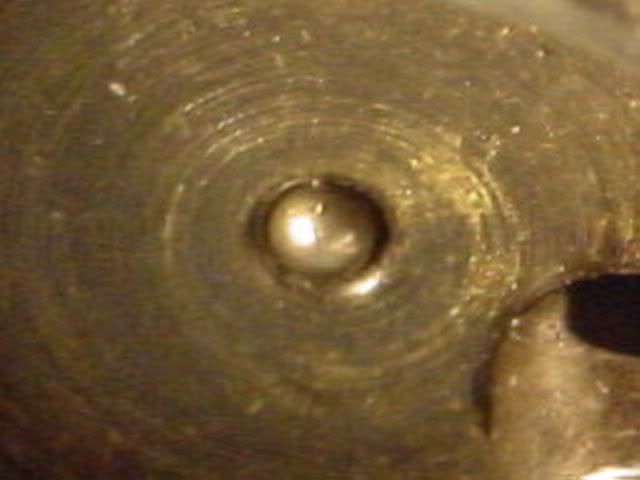 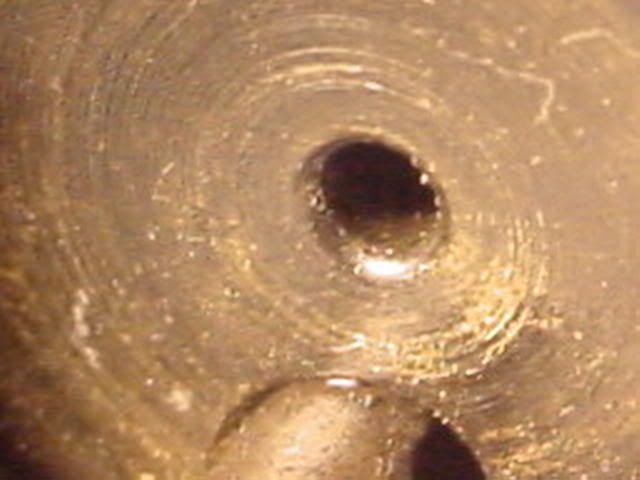 The close fit of the firing pin is shown, so there is not a gap of the firing pin and hole causing a situation. There is a minor chamfer on the front edge of the firing pin hole, and the tiny relief allows a small amount of primer flow into that section. I have information forthcoming from the top man at Remington for repair and legal testimony. He is the guy that does the expert witness exams for Remington. I got lucky in finding him at Remington, and had a chance to see him at the NRA show here in St. Louis recently. When the info. arrives, I will post the official Remington information. More to come. [email protected] |
|
|
|
|
#25 |
|
Senior Member
Join Date: July 6, 2006
Location: Planet Earth
Posts: 976
|
In the DPMS, the chamber may have excess runout at the mouth. This can be caused by coolant failure, or a dull flute on the reamer. If the chamber mouth runs out, the chamber may be the correct size everywhere but in a localised area. a go-no go gauge will not show this. An optical comparator would. I'm not saying this is cause of the uneven expansion here, but it could be.
As WA says, send it back with some fired cases. 55,000 PSI is nothing to take chances with. PS. I am not a gunsmith, I am a toolmaker. |
|
|
 |
|
|